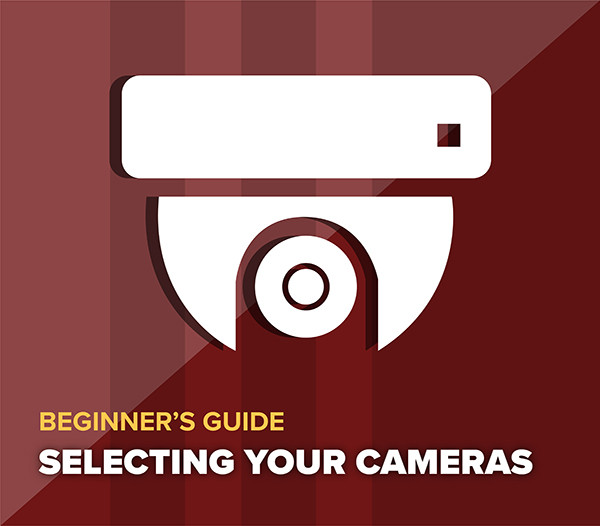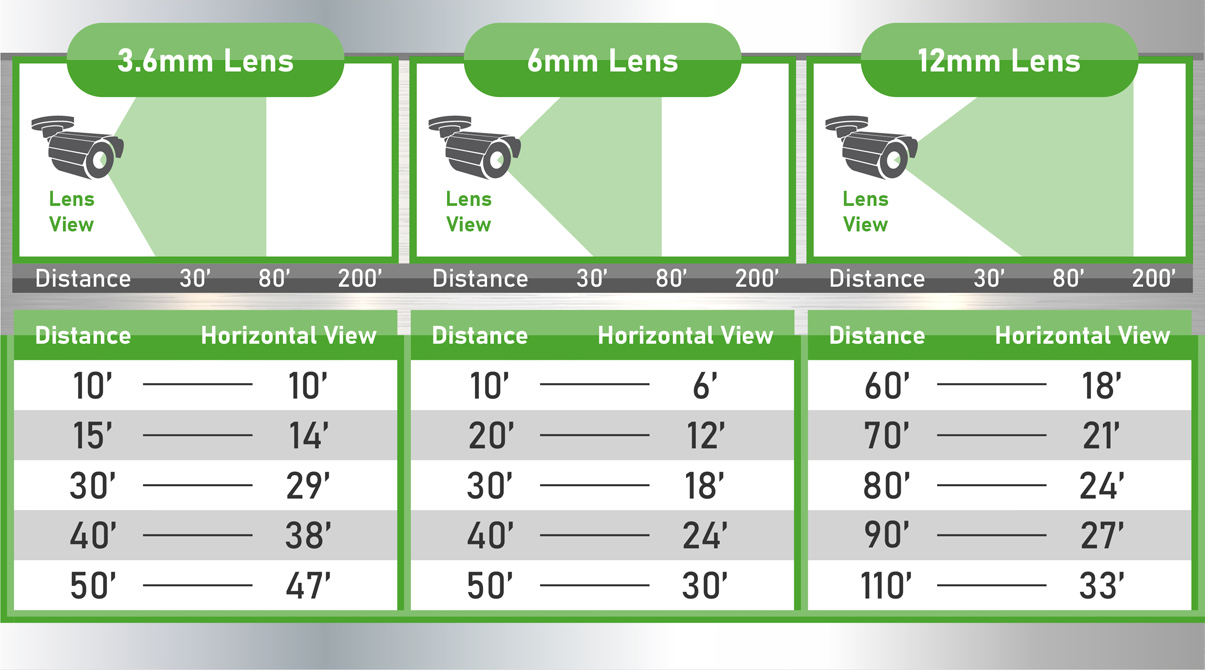
There are four things to consider when selecting the right camera. We’ll teach you about each one and show you how easy it is to get it right.
- Which housing should you choose?
- Which lens should you use?
- What resolution do you need?
- What night vision distance is needed?
Housings

The “Dome Style” camera is designed for indoor use. They are not nearly as popular as they were a few years ago as the new "turret/armored" designs have taken the market. The Dome style is good at hiding the lens but does not have the best night vision systems due to the plastic cover. The “Turret/Armored" or "Vandal Dome” while outdoor rated (IP76), they are often used indoors because of low ceilings and its small size. It is the perfect answer if the public may have access to the camera. The “Bullet or Box Style” is great for outdoor use. The housings are solid and designed for harsh environments. PTZ "Pan-Tilt-Zoom" cameras are used for large areas. The housing supports 3 motors: a heating/cooling system, a vertical and horizontal moving system, a motorized lens and camera electronics. PTZs are usually found outdoors and used for large area surveillance.
Lens
It’s amazing that so many security cameras are sold online and rarely does anybody ask about the lens in the camera. Why? The camera lens dictates what the camera can see. To choose the right lens, you only need to know two things:
How large of an area do you need to view?
How far away is it from the camera location?
These two distances dictate what size of lens the camera will require. Choosing the right lens is simple if you understand the relationship between the horizontal viewing area and the distance from the camera.
The chart below shows that a 3.6mm lens provides a 29 foot horizontal view at a 30 foot distance from the camera. The 6mm lens provides an 18 foot horizontal view at 30 feet from the camera. Because the 6mm lens provides a smaller horizontal view, an object at a 30 foot distance from the camera would appear larger and have more detail in the video.

With this information, you can see that there are only two factors that you need to know in order to choose the right lens: the distance from the camera to the area you would like to view and the horizontal distance you want to cover. For example, if you want to view an area that is 80 feet from the camera and need a horizontal distance of 20-24 feet, the chart above indicates a 12mm lens would be a good choice.
The Brilliance of a Manual & Motorized Zoom Lens
Many of our cameras are equipped with a manual or motorized zoom lens. The manual zoom lens allows you to mount the camera and then, using the zoom knob on the camera, you can manually adjust the viewing area. This allows you to adjust until you get the perfect view. Motorized zoom lenses allow you to optically zoom the cameras view in or out, right from the video recorder or your smart phone. Because of this flexibility, we highly recommend a camera with a zoom lens when surveilling areas further than 60 feet from the camera.
The Pro’s Golden Rules to Selecting the Right Lens
- If the viewing area is under 50ft from the camera, select a 3.6mm fixed lens.
- If the viewing area is 5-150 feet from the camera, select a camera with 2.8-12mm zoom lens.
- If the area is 20-400 feet from the camera, consider PTZ cameras with a motorized zoom lens.
Camera Resolution
There are many aspects to resolution but, for our needs, we’ll keep it simple.
- Resolution is a way to measure the size of the video being produced.
Smaller images produce low resolution video. Larger images produce HD or high definition video. It really is that simple. The larger the image being recorded, the higher the resolution and quality.

There have been many different resolution standards throughout the years. The latest that we recommend is 3K (5+ Megapixel) and 4K (8 Megapixel). Often the right choice is a 3K camera for general medium range surveillance such as hallways or an office. The smaller resolution allows for smaller hard drives and 3K cameras cost less than 4K. However, if you want crisp and clear detail at distance with superior digital zoom, then you should go with 4K cameras. Keep in mind that you can mix 3K and 4K cameras on the same system.
Night Vision
The majority of security cameras these days are equipped with night vision. The night vision technology built into the cameras is the most cost effective solution for day and night surveillance. The cameras automatically switch from day operation to night vision when the light level drops below a certain point. The night vision is very good, but you should expect to see a 10-15% drop in resolution in night vision mode.
Color Night Vision is a term that is used to describe ultra low light color operation. The camera provides clear color video at night with the presence of some ambient light; such as yard lighting, full moon or nearby street lights. If the ambient light is not adequate, the IR night vision system automatically turns on, providing high quality black and white night vision images when color is not possible due to a lack of ambient light.
More is not necessarily better when it comes to night vision. Always match the distance that the camera is expected to view with the night vision rating of the camera. If you use an overpowered night vision camera on an object too close, you will see “hot Spots”.


The Pro’s Golden Rules to Getting the Right Night Vision
Select a camera that’s night vision range is no more than double the expected viewing distance. For example, if your desired viewing distance is 60-80 feet from the camera location, we would select a camera with a 120 foot night vision distance. If your desired viewing distance is 30 feet, we would not recommend a camera with night viewing distance stronger than 60 feet. In short, the sweet spot for night vision is 50-80% of the camera's maximum night vision distance.
Thank you for contributing!
We would love to hear your point of view, thoughts or comments. Post a reply below or share this post on social media, then send us a link to the post - sales@backstreetsurveillance.com. We'll send you a special discount code giving you maximum savings at checkout. As always, your email is protected and only used to send the discount code.




